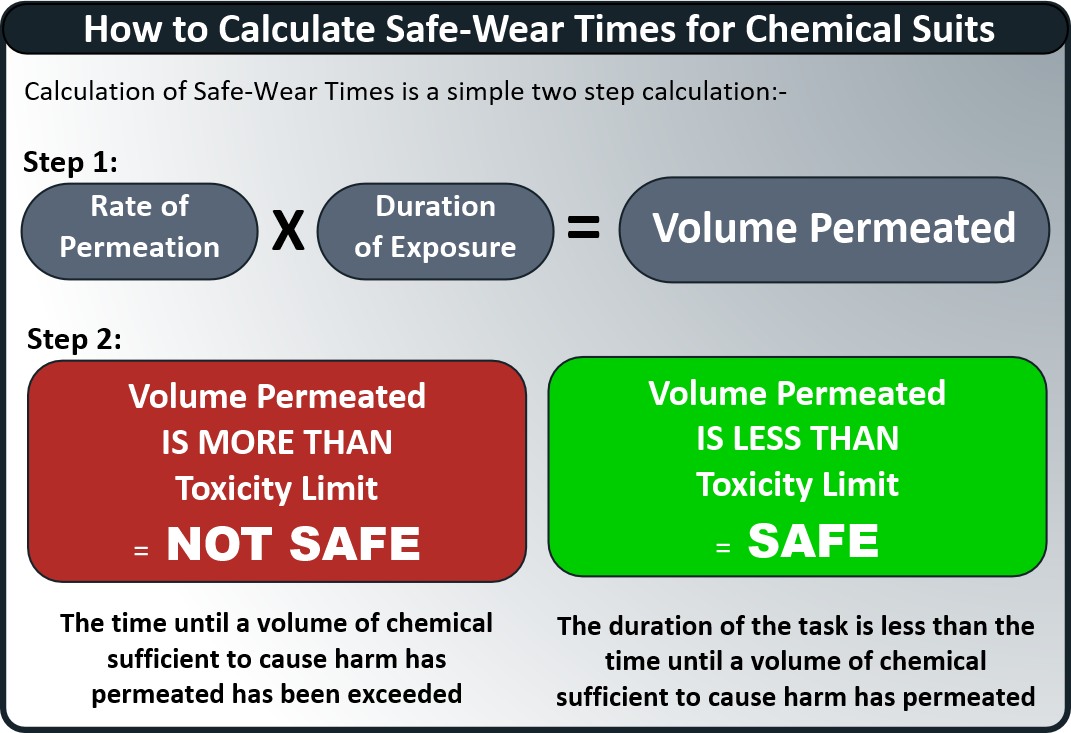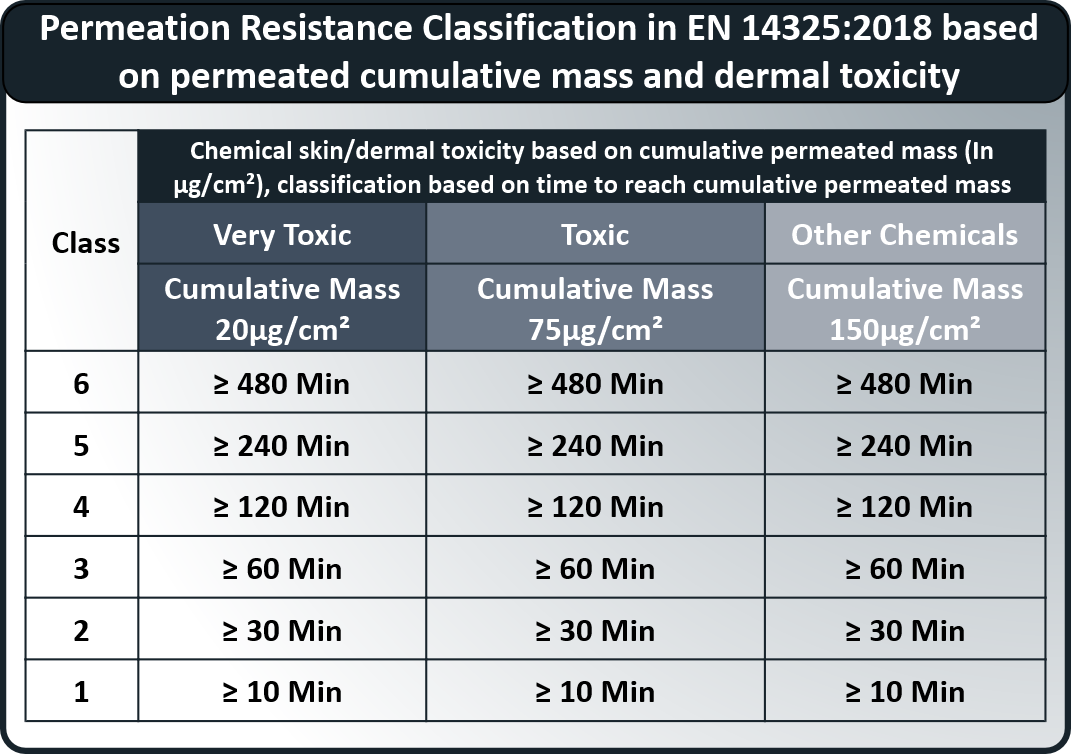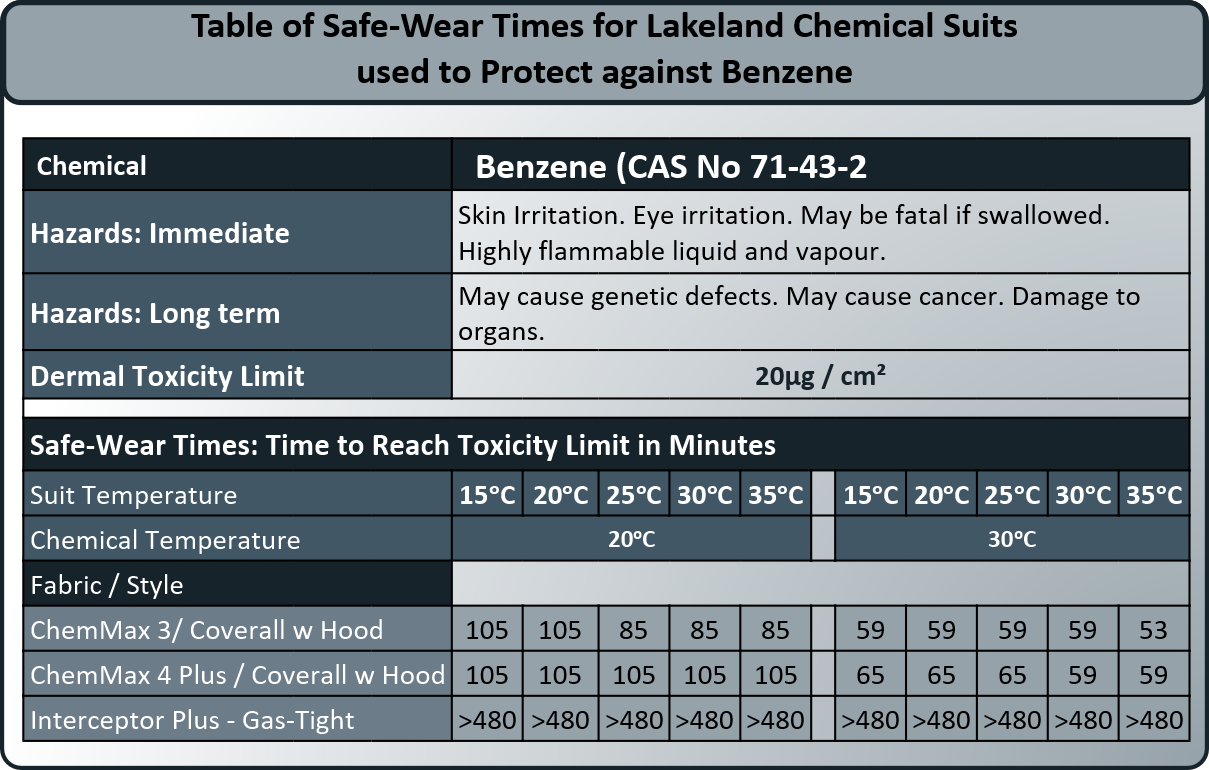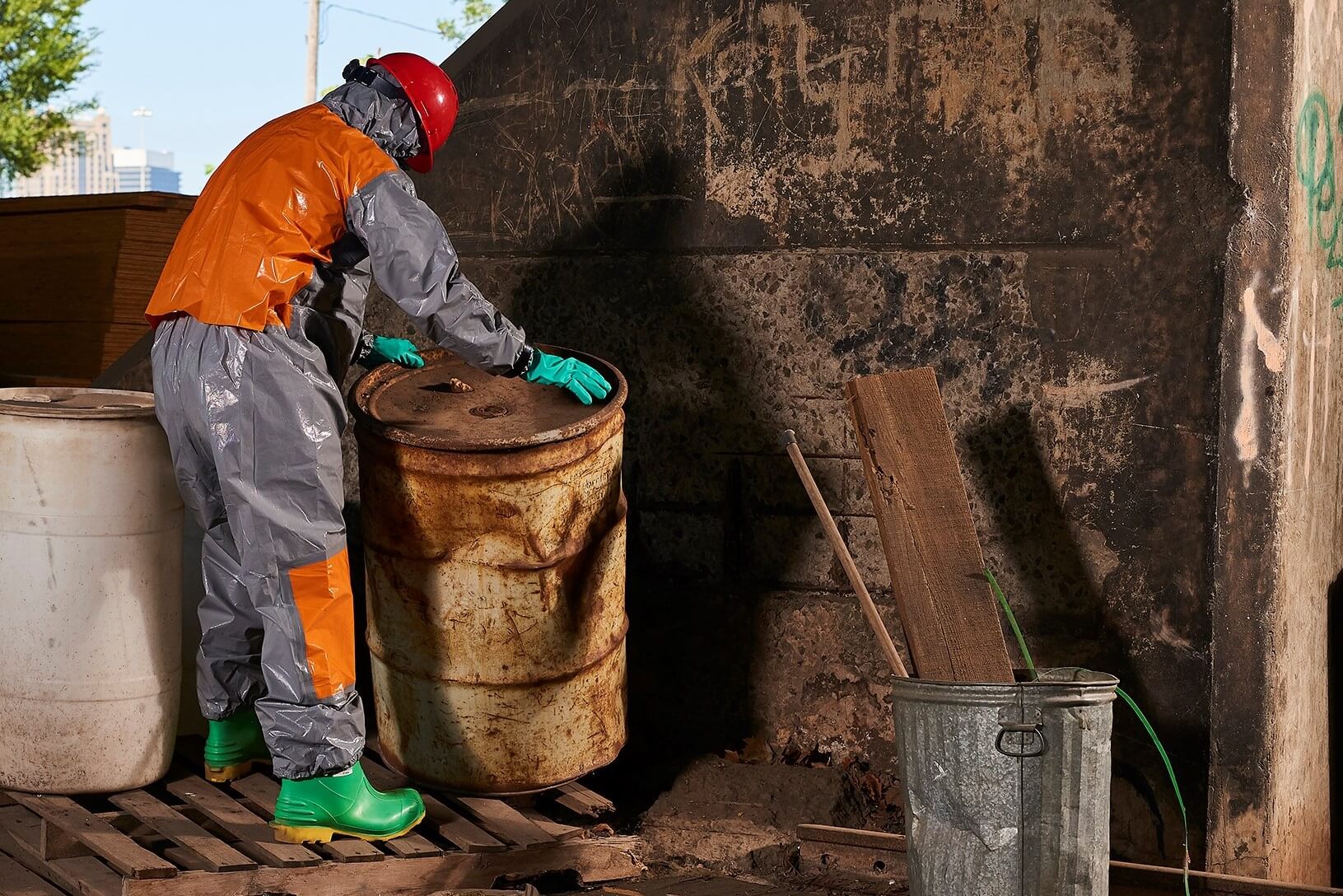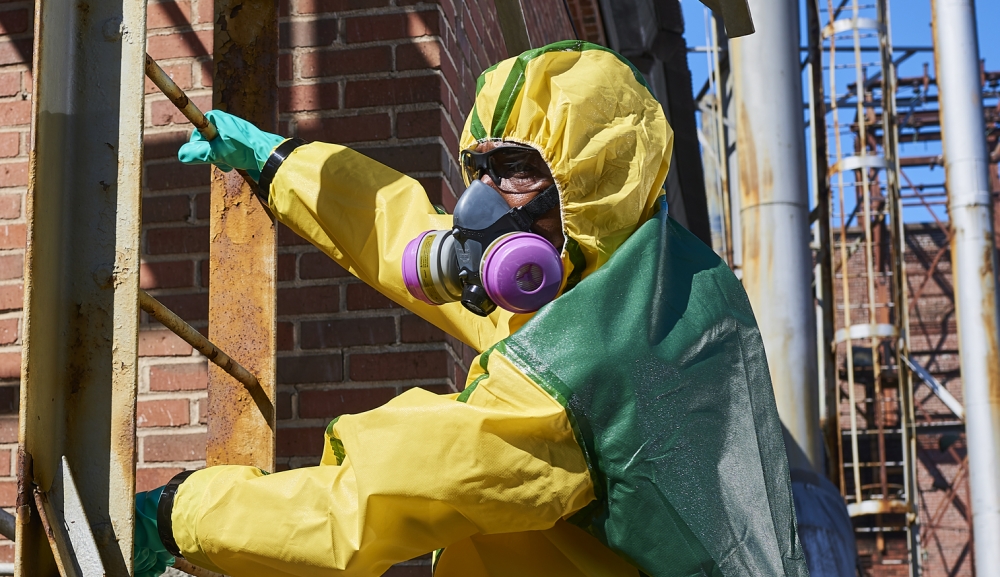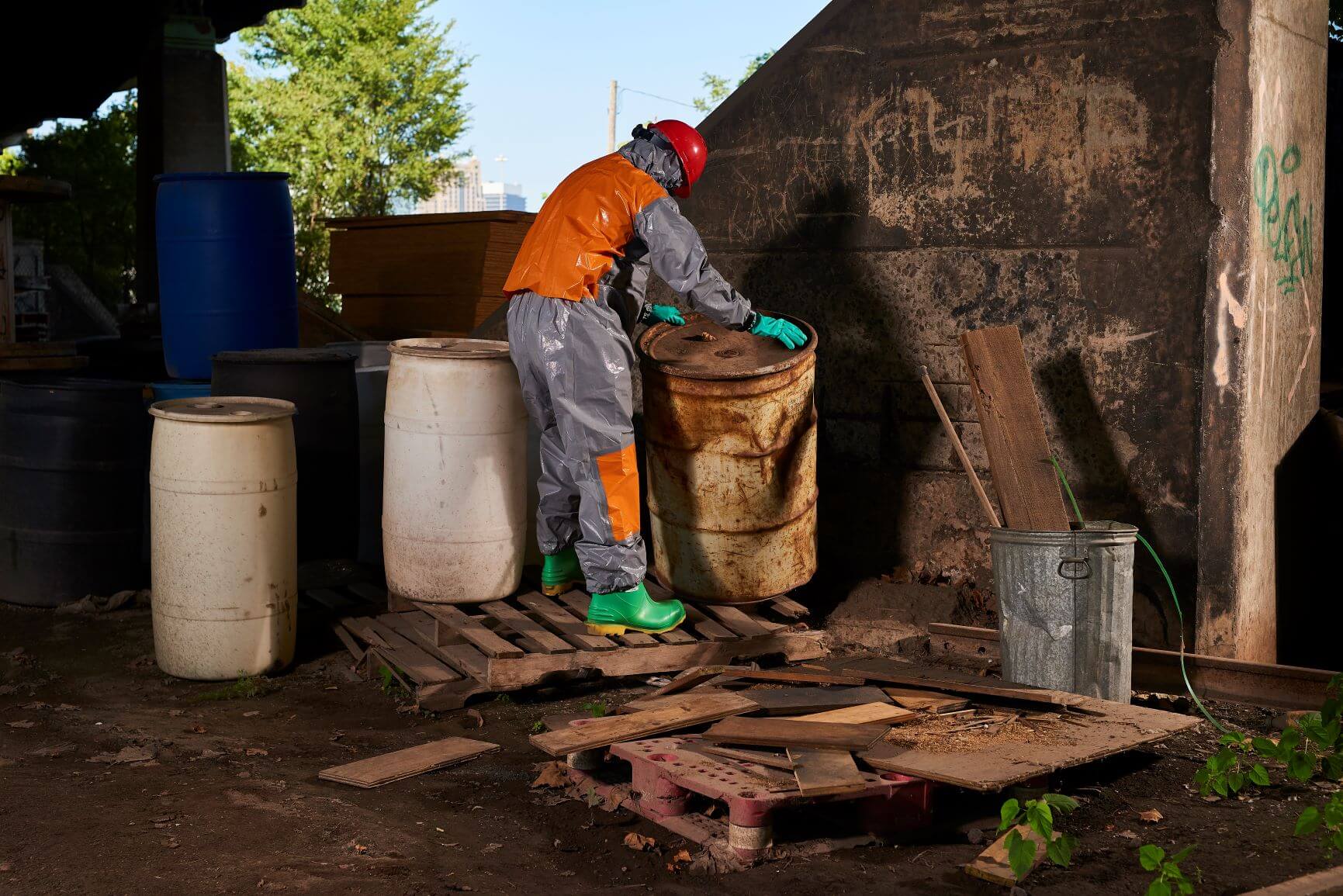If you have read our previous Chemical Safety at Work blogs you will have reached two major conclusions:-
- “The Hidden Killers” demonstrated many chemicals have properties that make them a more insidious threat than other hazards; there is a real risk that workers can be contaminated without realizing… and may not realize until serious health problems develop sometimes years or even decades later… at which point of course, it is too late.
- “Permeation test data is not what you think” showed that the current use of permeation test data – the “breakthrough” commonly used globally by users to indicate a suit is safe to wear actually does not indicate that at all. Using it as such could mean that users believe they are protected from a chemical when in fact regular contamination may be a reality.
Put these two conclusions together and the danger is clear; contamination by a chemical may not be noticed and yet could be extremely dangerous; and the current method of assessing whether a suit is protecting against a chemical is widely misused so that wearers might be being contaminated when they think they are safe.
This is important information to understand – but does not solve the problem for the safety manager looking to effectively protect his workers from chemical hazards in the workplace. Understanding that test breakthrough is not a safe-wear time leaves open the question of “how long am I safe?” This, being the final part of our chemical safety at work blog trilogy, will address this question by looking at the following points:-
- The differences between permeation and penetration and why it matters for chemical protection
- How to calculate safe-wear times for chemical suits.
- Complications: temperature and vaporization
- The EN 14325:2018 Solution
- A Health and Safety Plan for Chemical Protective Clothing
- The “Permasure®” Solution
Permeation vs Penetration: The difference and why it matters for chemical resistant clothing
The consequence of both permeation and penetration are the same; a chemical challenges a barrier and some of that chemical ends up on the opposite side of that barrier. However, there are key differences in the process that have consequences for understanding chemical protective clothing and safe-wear times. The short video below shows the essential difference.
Whilst PENETRATION is a MACRO level process where a chemical physically passes through holes or gaps in the structure of a non-barrier fabric, PERMEATION is a process occurring at a MICRO level whereby the molecules of the chemical pass between the molecules of the material itself. No holes or gaps in the structure of the barrier are required. Permeation will occur through a “solid” barrier*. The key differences and consequences are shown in the table below:-
| Penetration | Permeation |
| Occurs at macro level: a liquid passes through holes or gaps in the structure of a barrier | Occurs at a micro, molecular level: the molecules of the liquid pass between those of the barrier |
| ONLY occurs if there are holes or gaps for the liquid to pass through | Occurs even if there are no holes or gaps in the structure. Permeation will happen through a “solid”* barrier |
| Can be prevented. As long as there is a “solid”, undamaged barrier penetration will not take place | Cannot be prevented. Even with a “solid” barrier permeation WILL occur. The questions are when and how quickly? A chemical suit fabric cannot prevent permeation indefinitely, only delay and slow it. |
| Deals with visual quantities of the liquid. The penetration test (EN 6530 – used to assess Type 6 garments) is largely a visual assessment.
Thus, penetration is more relevant for chemicals that are harmful in relatively large volumes – such as paints or weak cleaning fluids that may be harmful in larger quantities or acids with a sole hazard of causing burns. |
Deals with very small volumes of a chemical – measured in “micrograms” (“µg”: A microgram is one millionth of a gram (0.000,001 grams) so is an extremely small measure). The permeation test (EN 6529 – used to assess garment Types 1 to 4) measures permeation rate in micrograms per minute.
Thus, permeation is relevant for chemicals that have health consequences in very small volumes |

- A chemical suit barrier fabric CANNOT prevent permeation. It can only delay or slow it. Permeation will happen at some point. The questions relate to when and how much?
- Because permeation deals with such small volumes it is only relevant for chemicals that are hazardous in small volumes. Permeation is of limited importance for chemicals such as an acid who’s only effect is skin burns; a few micrograms of an acid will not result in much of a burn. In other words it is those chemicals that have long term health effects as we considered in “The Hidden Killers” blog, for which permeation matters.
How to calculate safe-wear times for chemical resistant clothing
What Information is needed?
Given that permeation will happen at some point, in order to understand how long a chemical suit can be worn safely we need to know how much of the chemical may permeate over time and whether that amount of is harmful, or in other words, how long can the suit be worn before the volume permeating might cause harm?
There are two pieces of information required to answer this question:-
- How much of the chemical will permeate over time – the “Volume Permeated”?
- How much of the chemical is required to cause harm – it’s “Toxicity Limit”?
Clearly, with these two numbers it then becomes a very simple assessment:-
- If Volume Permeated is MORE THAN the Toxicity limit then you are NOT SAFE; you have exceeded the point where more than sufficient chemical may have permeated to cause harm.
- If Volume Permeated is LESS THAN the Toxicity Limit then you are SAFE; you have not reached the point at which sufficient chemical may have permeated to cause harm.
How to calculate Volume Permeated
The good news is that calculating volume permeated is a simple mathematical sum; the bad news is that the information needed to perform that sum is difficult to access. Again however, you need just two pieces of information:-
- The RATE OF PERMEATION of the chemical through the fabric
- The possible DURATION OF CONTACT with the chemical. In other words, how long is the suit exposed to the chemical? The EXPOSURE TIME.
Multiplying these two together will give us the total volume permeated over time or the CUMULATIVE VOLUME. So, if the Rate of Permeation is 2 micrograms per minute and the exposure time is 30 minutes then the calculation is:-
- 2 x 30 = 60
- Cumulative Volume is 60 micrograms, or after 30 minutes 60µg of the chemical will have permeated through the fabric.
In practice permeation rate would also be measured per cm2 of surface area (µg/min/cm2), so we would also need to multiply by the area contaminated to obtain the full volume. However, since dermal toxicity limits for chemicals are normally measured in micrograms per cm 2, this is cancelled out for the purposes of this simple hypothetical illustration.
Complications: Temperature and Vaporization
If only it was that simple. Unfortunately, though predictably given life never is that simple – there are complications. The first is temperature. The second is the boiling point of the chemical and consequently whether any of it will vaporize, and if so, how much?
The Complication of Temperature
Temperature is important primarily because the speed at which the chemical permeates through the fabric is likely to increase as the temperature rises. So more chemical will permeate through a barrier in the same time at a temperature of 20oC than would at 10oC. As a very rough rule of thumb the rate of permeation may double with every 10 degree rise in the temperature of the fabric.
Permeation tests (according to EN 6529) are conducted at a standard 23oC. (The is because the purpose of the test is comparison of fabric performance, so if tests were NOT conducted at a standard, controlled temperature the results would not be comparable). So if a permeation test is the source of a permeation rate used for a volume permeated calculation, the effect of the temperature in the environment where the work takes place will need to be considered.
Predicting Chemical Suit fabric Temperature |
|
The change over time will be affected by various influences, not only the ambient temperature of the environment, but also the presence of any radiant heat sources (such as the sun!), the workers’ body temperature and work rate. Even the individual physiology of the wearer will influence how much heat energy they generate; strenuous activity will generate more heat energy and higher temperatures than one that is stationary. Any prediction of suit temperature should consider these influences. Good practice would be to calculate volume permeated at a range of temperatures to provide a comprehensive picture of safe-wear times. |
In summary any calculation of volume permeated should consider the temperature of the suit fabric and its influence on permeation rate. To complicate things further however, temperature will also affect vaporization of the chemical.
The Complication of Vaporization
Every liquid has a boiling point above which it will cease to be a liquid and become a vapor. Vapors behave differently than liquids and, depending on the chemical may behave more like a dust floating in the atmosphere, being drawn with flows of air. An extreme example of an easily vaporized chemical is ammonia which has a boiling point of -33oC so at normal temperatures is a vapor.
The air inside a chemical suit is constantly shifting around as the wearer moves. The result is air is forced in and out of openings in the protective ensemble This is known as the “Bellows Effect” and in the case of chemical suits with sealed seams and front fastenings is usually limited to the connections with other PPE such as the face mask, gloves and boots. The result is that more chemical vapor is likely to come into contact with the suit fabric and vapor will have an increased tendency to be drawn into the suit through any potential openings available.
Any health and safety risk assessment referencing a hazardous chemical should consider the tendency of the chemical to generate vapor which will much more readily find its way inside a suit. In some cases this might mean that gas-tight protection and a Type 1 suit is appropriate.
Subject to the complications of temperature and vaporization the calculation of volume permeated as described above is relatively simple:-
The difficulty is knowing what the permeation rate is for a particular chemical against a specific chemical suit fabric and in assessing the effects of temperature and vaporization in order to make that calculation. One source might be a permeation test which can indicate the rate of permeation – but remember tests are conducted at 23oC only so adjustments would need to be made.
How do you know the Toxicity Limit of the chemical?
As well as the Volume Permeated of chemical over time, we also need to know its Toxicity in order to compare the two. “Toxicity Limit” can be generally defined as the amount, volume or mass of the chemical that is likely to cause harm to a person, normally defined per cm2 of surface area. Chemicals have differing levels of toxicity; some are highly toxic, requiring only a small amount to cause harm; others have relatively low toxicity requiring more to cause harm.
Clearly, for any given chemical “the amount required to cause harm” will depend on a variety of factors including the physiology of the person contaminated; for example, I can drink only a relatively moderate volume of beer before its (mercifully mostly short term!) harmful effects become apparent. I have friends on the other hand who can readily drink the entire contents of a medium sized bar with barely a slurred word apparent. The most extreme examples of high toxicity are chemical warfare agents, of which even tiny amounts can kill hundreds or even thousands. It is difficult to identify very specific toxicity limits. However, for most chemicals three general levels of cumulative toxicity – the volume permeated over time – are identified:-
| Designation | Toxicity Level |
| “Very Toxic” (or High Toxicity) | 20µg/cm2 |
| “Toxic” ( or Medium Toxicity) | 75µg/cm2 |
| “Other Chemicals” (or low Toxicity) | 150µg/cm2 |
The terms “Very Toxic”, “Toxic” and “Other Chemicals” are those used in the cumulative permeation table introduced in EN 14325:2018. They limits are taken from those defined in EC Regulation 1272:2008 (see below)
Dermal Toxicity limits for specific chemicals, along with known hazard details can often be obtained from chemical safety data sheets supplied by manufacturers. Two good, authoritative sources are:-
The European Chemical Agency, “ECHA”: https://echa.europa.eu/
The US Centre for Disease Control and Prevention IOSH guide to chemical hazards: https://www.cdc.gov/niosh/npg/
European Regulation 1272: 2008, which covers labelling and safety precautions when handling chemicals also features hazard data and toxicity limits based on the three levels described above. In fact, it is these providing the source for those used in the permeation classification table in the 2018 version of EN 14325.
The EN 14325:2018 Solution
The 2018 update of this standard introduced a new classification for permeation resistance which goes some way towards answering the question “how long am I safe?”
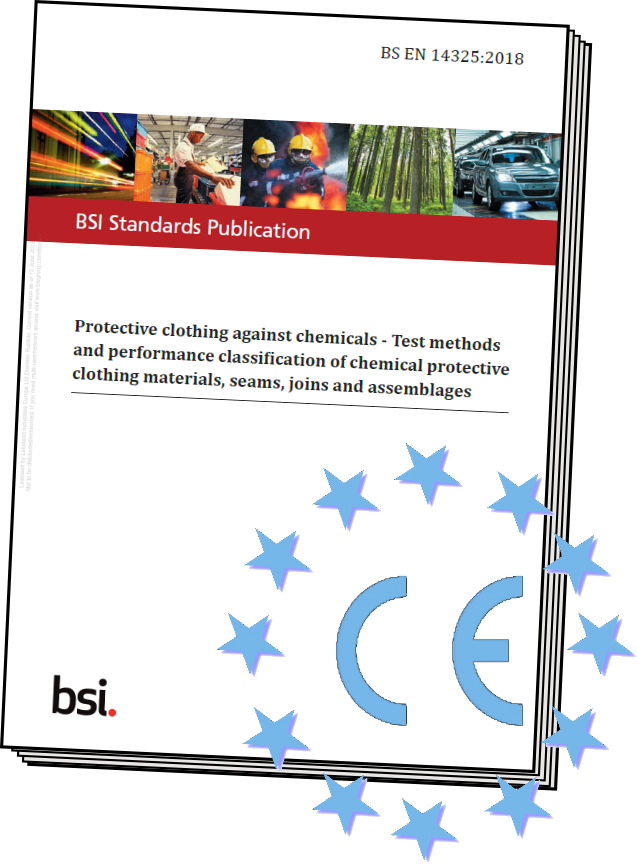
What is standard EN 14325?Many do not recognize this standard even though it is vital for ALL protective clothing. The confusion stems from the fact that it is neither a product standard nor a test standard (although it does contain some specific test methods) EN 14325 is primarily a “reference standard”; it references test methods described in other test standards and provides the tables for classification of the results of those tests. Protective clothing product standards (such as EN 14605) refer to it for classification tables for fabric physical properties such as abrasion resistance and tear resistance, seam strength, penetration and permeation resistance which are all detailed in EN 14325. |
This new classification is shown in the table below:-
The new system includes three classifications based on volume or mass of chemical permeated and according to the three toxicity levels as described above – 20µg, 75µg and 150µg per cm2.
A user of this table would classify a chemical suit fabric by first determining which of the toxicity levels applies to the chemical in use. A permeation test can be used to indicate how long it will take until “cumulative permeated mass” (or the “Volume Permeated”) reaches that toxicity level. Thus this new classification is based on the same comparison of Volume Permeated with Chemical Toxicity as described in this blog.
For example, benzene is a “Very Toxic” chemical with a dermal toxicity of 20µg/cm2. Information provided with the suit stating a “Class 4” for benzene would indicate that the time to reach the cumulative mass of 20µg/cm2 is between 120 minutes and 240 minutes, which can be interpreted as “the maximum safe-wear time for the suit is 240 minutes”.
This is useful and at least a step forward from the misunderstood “breakthrough” time used by the existing classification and seen in our previous blog “Permeation Test Data is not What you Think”, but fails to account for the effects of temperature and vaporization so has limitations. If used care must be taken to consider those effects given that the permeation test on which it is based is conducted at 23oC.
CONCLUSION: A Health & Safety Plan for Chemical Protective Clothing
Having seen the essential method of calculating a safe use time using volume permeated and chemical toxicity along with the issues that should be considered in calculation it. But how would this fit into a safety managers’ planning for effective chemical protection? A simple health and safety plan should consist of at least* the following elements:-
- Understand the chemical
- What are the immediate or short-term effects of contamination – if any?
- What are the long-term effects of contamination – if any?
- What is its boiling point? (is it likely to easily vaporize and require gas-tight protection?)
- What is its dermal toxicity limit? (Refer to EC Regulation 1272:2008 or similar source)
- Calculate Volume Permeated over time taking account of temperature and possible vaporization and that temperature may vary (probably increase) over the duration of the task
- Assess safe-wear time based on the volume permeated and chemical toxicity limit using the calculation described in this blog.
- Understand the nature of the possible contact with the chemical to indicate a choice of garment design and construction according to chemical protective clothing Types 1 to 6. (This should be subject to the relative hazard; for example a Type 6 spray might need even a gas tight suit if the chemical is highly toxic)
- Consider any factors in the task itself that might influence garment choice and safe duration of task (e.g., sharp edges; stressful movements such as climbing or crawling etc.)
- Consider any factors in the environment that might influence garment choice and safe duration of task (e.g, warm environment; light levels; other hazards etc.)
- Consider any other PPE also required and how the different items of PPE, including the chemical suit will work together
The advantage of using a method of calculating safe-wear times such as described here as part of your health and safety plan is that it becomes possible to develop tables of safe-wear times for different chemical suits against frequently used chemicals according to the varying conditions in which protection is required and in which tasks may take place. This can be a very useful tool for any safety manager wishing to apply a more rigorous method of managing and protecting against chemical hazards in the workplace (and, to be clear, a more correct -method given that commonly the current use of permeation test “breakthrough” is simply wrong). An example table for benzene is shown below:-
A table like this can form the basis of a simple health and safety plan for managing benzene;
- knowledge of the immediate hazards can indicate any remedial action required for (in this case) skin or eye contact in larger amounts of contamination
- Safe-wear times based on the possible time to reach the defined toxicity limit at a range of suit and chemical temperatures will enable effective choice of a suitable garment and comprehensive management of tasks to ensure that the toxicity limit is not breached.
Safety chemical hazard plans such as this can serve as a quick reference guide for safety and site managers planning tasks and requiring information on how long suits available will safely protect workers, thus contributing to safer and more authorized management of chemical hazards.
It is worth noting that this does not necessarily mean an increase in the cost of PPE. On the contrary, because it provides more accurate information about how long a specific suit can be safely worn it allows safety managers to target protection more effectively with the optimum chemical suit for the job rather than having to provide more expensive options “just to be safe”. The result can be a reduction in PPE costs.
Such a method heralds a more effective solution for managing chemical hazards in the workplace. Information about chemical hazards (where it exists!) is readily available. However, as we have seen, whilst the calculation to identify Volume Permeated over time and consequent safe-wear times is simple, the challenge in achieving this lies in sourcing the information – especially the rate of permeation at different temperatures. Information can be gained from a permeation test if the correct information is recorded, but even that fails to address the effects of temperature and vaporization so assumptions and estimates would be needed.
And this is where the Permasure® solution comes into its own.
The Permasure® Solution
The table of safe-wear times for benzene above was generated in just a few minutes using Permasure®.
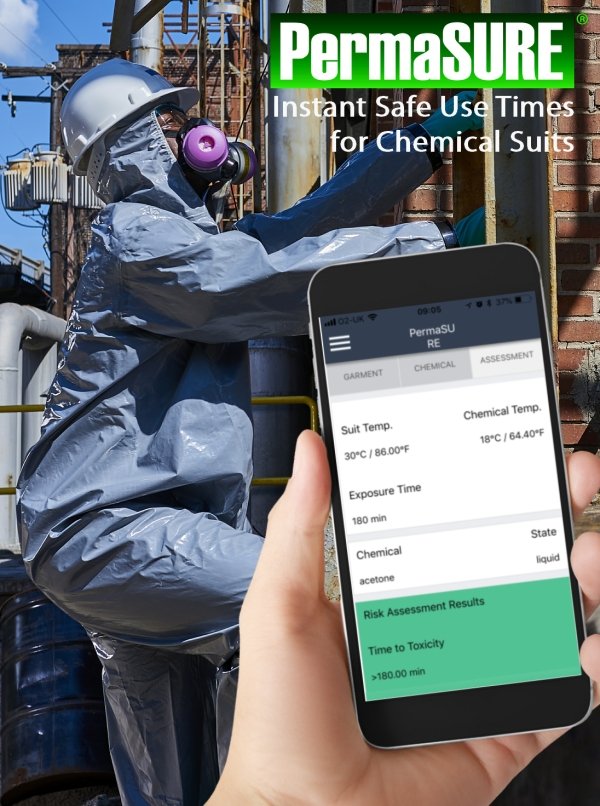
- Removes the need for time consuming testing through the use of well-established molecular modelling.
- Accurately predicts permeation rates at different temperatures, enabling calculation of volumes permeated
- Includes hazard information and toxicity limits (based on EC Regulation 1272) for over 4000 chemicals
- Uses an easy-to-use interface to input suit type, chemical and suit temperature, exposure time and choose from over 4000 chemicals
- In seconds performs calculation of safe-wear time assessment for Lakeland chemical suits ChemMax3, ChemMax 4 Plus and Interceptor Plus
In short, Permasure® is a free to use app that performs precisely the safe-wear time calculations described in this blog for over 4000 chemicals… and in seconds… thus solving the problem for safety managers wishing to introduce a system of using safe-wear times to manage chemical hazards in the workplace but finding the challenge of sourcing the basic information required insurmountable.
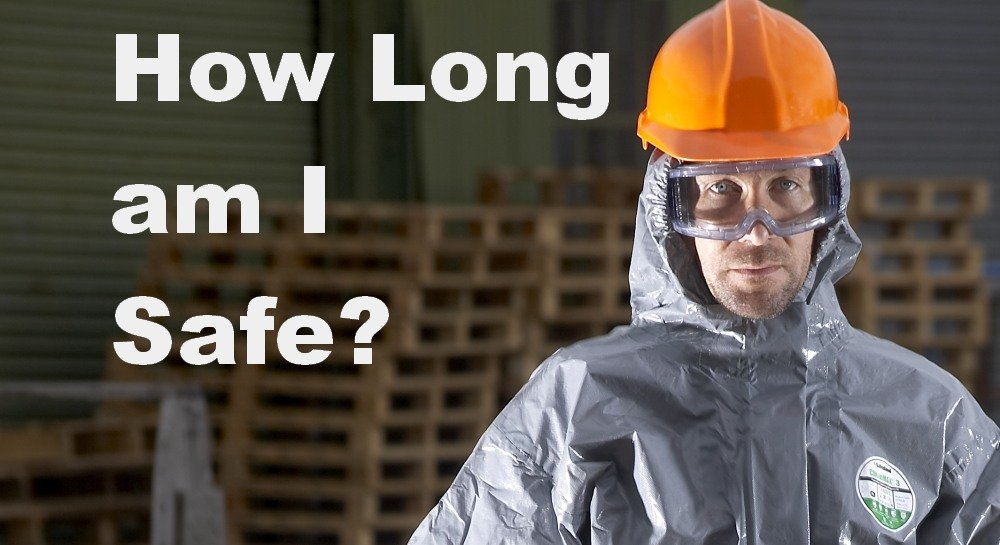
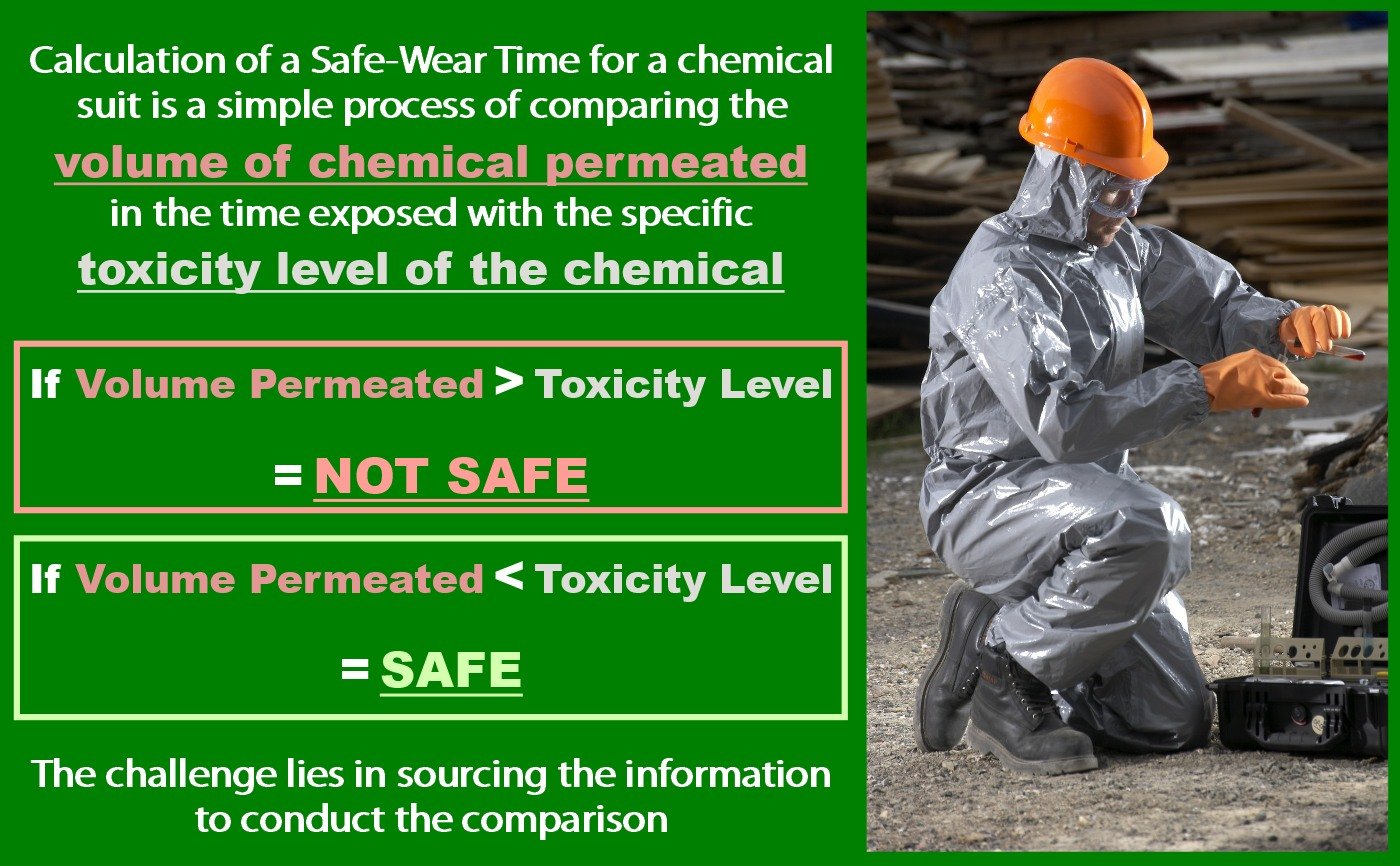
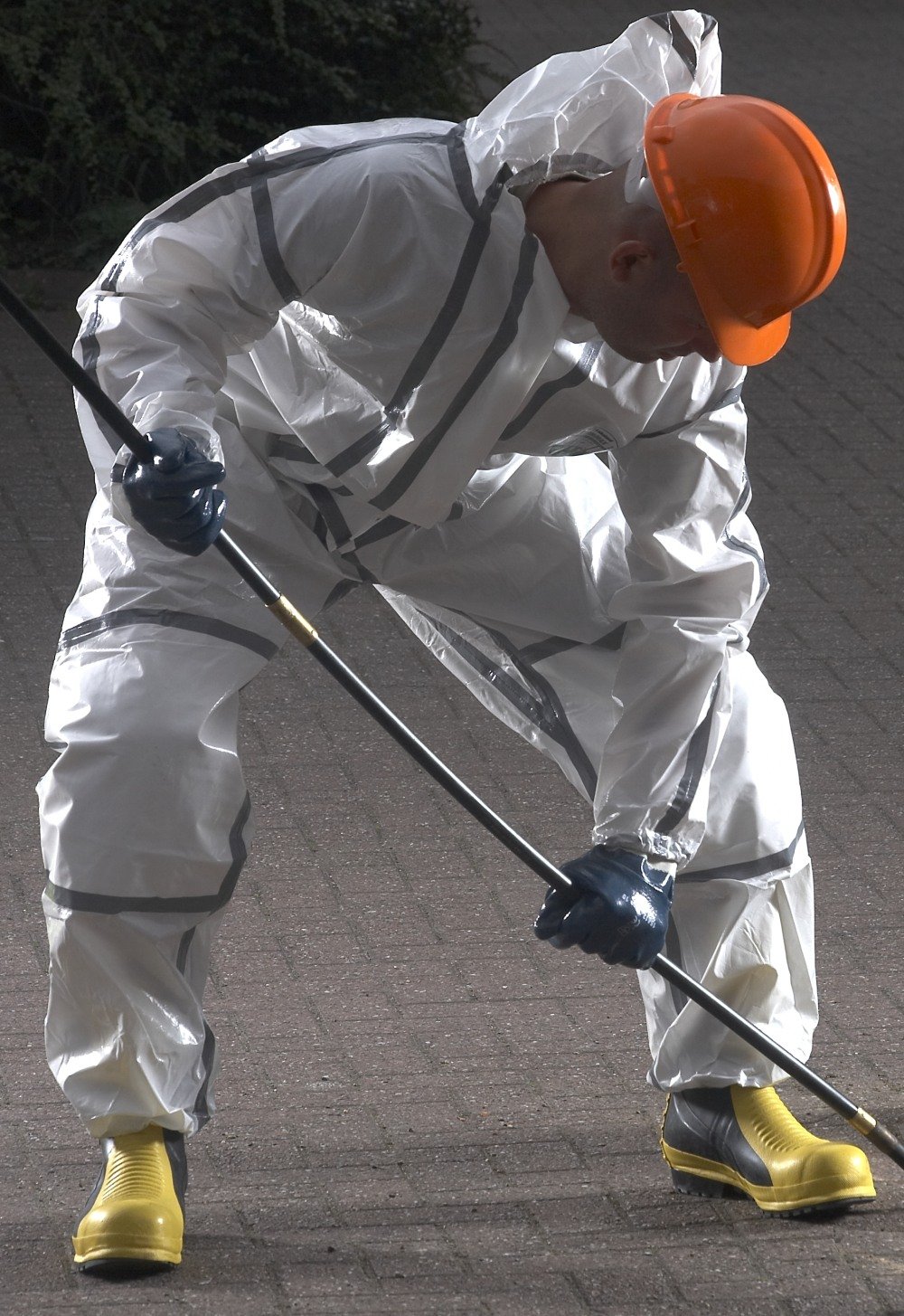 Predicting or monitoring the temperature of a chemical suit in use is not an exact science. Taking the temperature of a suit using an infra-red thermometer scanner before it is donned will provide a starting point, but whatever the temperature of the suit is at that time, it will inevitably change during performance of a task.
Predicting or monitoring the temperature of a chemical suit in use is not an exact science. Taking the temperature of a suit using an infra-red thermometer scanner before it is donned will provide a starting point, but whatever the temperature of the suit is at that time, it will inevitably change during performance of a task.